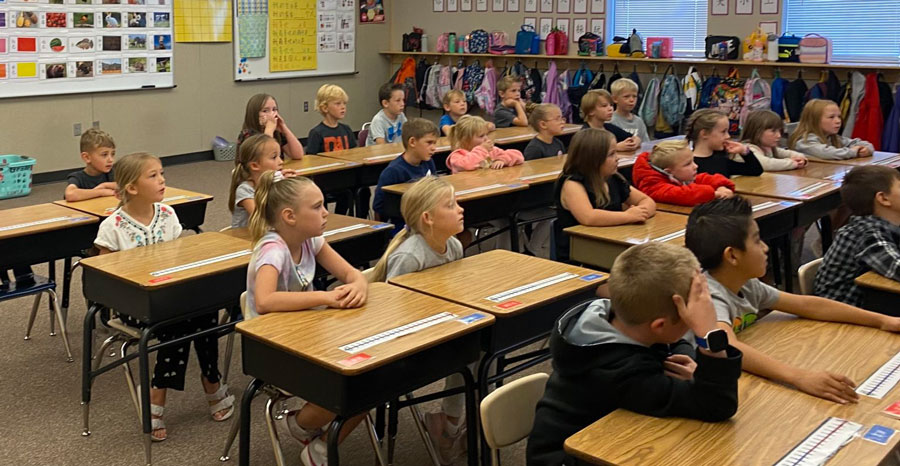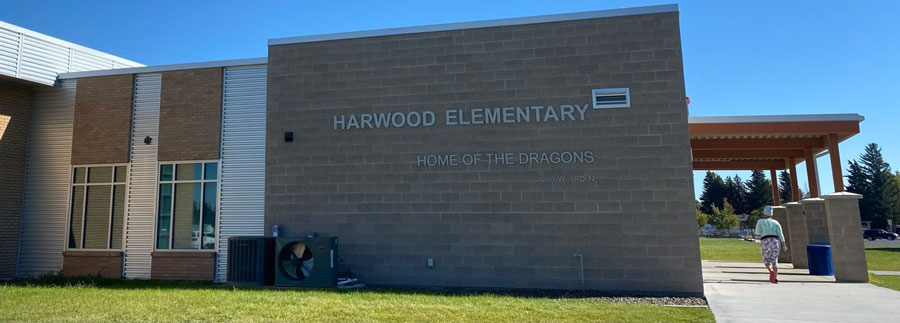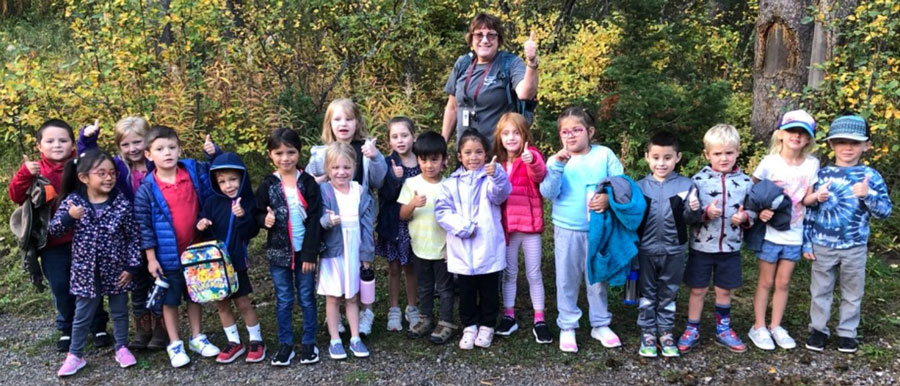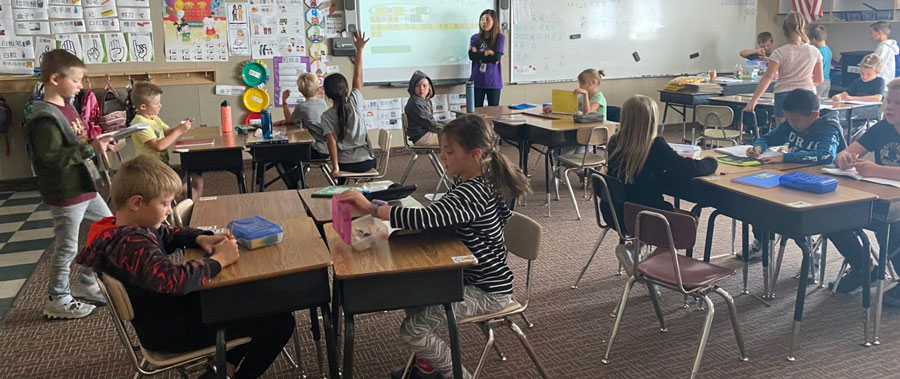Learning another language at a young age in eastern Idaho
Published at
RIGBY (IdahoEdNews.org) – Lorena Reyes remembers feeling different when she was a kindergartner.
The daughter of Mexican immigrants, she only spoke Spanish, and there weren’t many other kids like her.
“I felt like the odd duck out, like I didn’t belong,” she said.
That feeling stayed with her until she met her fourth grade teacher – a Spanish speaker like her. Inspired and less alone, Reyes dreamed of leading her own classroom one day.
Years later, she is.

Today, Reyes teaches fourth grade at the same elementary – Harwood – that she attended as a kid. But there’s one major difference: Jefferson County School District now offers Mandarin and Spanish immersion programs. Reyes teaches in the latter.
If that program were in place when she was a student, Reyes said she would’ve been more connected to her peers, more confident in her abilities, and less shy about communicating her knowledge to the teacher –a fear of speaking in imperfect English wouldn’t have held her back so much.
But her three children are getting the experience she missed out on.
Reyes knew they’d become bilingual in English and Spanish, so she opted to enroll them in the Mandarin dual enrollment program. They are now becoming trilingual.
“I wanted to open the door to more opportunities for them,” Reyes said. “I wanted them to see things through a different view.”

Jefferson County is one of a handful of school districts in Southern Idaho with growing dual immersion Spanish programs, though it is the only one that also offers Mandarin. Officials at those districts – which also include Jerome, Teton, and American Falls – say language-learning leads to numerous benefits, such as:
- smoothing the academic transition for English language learners
- cultivating empathy among students
- sparking curiosity about different cultures, languages, and countries
- creating new career opportunities for students
- boosting student achievement on standardized tests
But language immersion also has its shortcomings.
Finding teachers who are fluent in Spanish or Mandarin can be challenging. In class, the language barrier means instruction is more surface level than it would be otherwise. And not all students see the programs through to the end.
Nonetheless, dual immersion is in demand and growing. This year, districts that offer language programs participated in a two-day conference in early August. Randy Jensen, the superintendent of the American Falls School District, said it was likely the start of what will become an official Idaho consortium.
Here’s what the dual immersion programs generally entail:
- At the elementary level, half the day’s lessons are in English and the other half are in Spanish (or maybe Mandarin)
- At the middle and high school level, two classes (often social studies and a language class) are offered in Spanish (or Mandarin)
While language immersion programs are growing, they aren’t completely new. Blaine County’s dual immersion program, which has been operating for 22 years, is one of — if not the — oldest in the state.
Blaine County’s dual immersion magnet school brings awareness to cultural diversity: “It’s just a beautiful thing.”
In most districts, various schools host dual immersion classes. In Blaine County, they’re all housed in one magnet school, Alturas Elementary, which principal Brad Henson said makes the program unique.
While any student can apply to attend the school, transportation can be a limiting factor. For example, a student in Carey would have to catch a bus as early as 5:30 a.m. to get to school on time.
Even so, 441 students are currently enrolled at Alturas.
Henson is proud of the program’s growth over the years, and was quick to extol the virtues of bilingualism.
“Anytime you can get another language under your belt, it’s a bonus,” he said. “Learning a new language helps offset dementia or Alzheimer’s, creates more job opportunities, provides a deeper understanding and respect for different cultures of the world … It’s just a beautiful thing.”
Henson aims to keep enrollment at about a 50/50 mix of native English speakers and native Spanish speakers. That way, the students can learn from each other. Each group gets to feel like an expert half the day, and a novice the other half.
The language programs also offer insight into various people, places, ideas, and values. “Spanish … is a plethora of many different cultures and dialects,” he said. “This type of school helps bring awareness to all of that.”
Henson said newcomers arrive in the community from Mexico and a number of South American countries. Many own small businesses, like restaurants or coffee shops, work for the Sun Valley resort, manage houses, work as landscapers or cooks, or find jobs in the construction industry. The Latin population there is more stable and less migrant than it is in other, more agriculturally-based Idaho towns, Henson said.
And of course, there are many Hispanic families who have lived in Idaho for generations.
In terms of academic achievement, Henson said dual immersion students tend to perform a bit lower than their English-only peers on standardized tests in elementary school, but start surpassing them by middle and high school.
“Our kids who stay in the dual immersion program tend to do well in school and many go on to college,” Henson said.
Teton embraces its multiculturalism: “We no longer live in monolingual communities.”
Megan Bybee, director of elementary education for Teton School District, has seen similar results. Learning in a new language is a heavy cognitive load for the first few years. With patience, though, those students eventually outperform their classmates.
The Teton Valley program is in its sixth year, and 265 students are enrolled in the program. Bybee tries to ensure that the demographics in the class match the demographics in the community; they aim to have at least 40% Hispanic students in the program.

Before the dual immersion program was in place, students arriving in the community who spoke only Spanish were thrust into English-only classrooms from day one. The full-on immersion was tough for those kids.
Now, those students can better ease into a new country, language, and culture because half the day is in their first language.
“We have native Spanish-speaking students who are able to be examples and be the shining light in the classroom – they’re the experts,” she said.
The Latin community generally comes to the Teton Valley to work in hospitality, tourism, and agriculture. In the past 4-5 years, Bybee said there’s been an uptick in new residents from South American countries like Peru, Colombia, Guatemala, and El Salvador.
The school’s curriculum celebrates that diversity with units in K-3 classes that feature different Hispanic countries and Mexican states.
Bybee said bilingualism has become more than a skill to list on a resume – it’s also “a benefit in daily living.”
“We no longer live in monolingual communities,” she said.
In American Falls, Jensen said that in his district, the program has engendered more interaction between Hispanic and non-Hispanic students and families.
“In our particular small town, it’s going to make a huge difference twenty years from now,” he said. “We will see a lot more engagement in our whole community.”
In the Jerome School District, about 52% of students are Hispanic and about 24% are English Language Learners, according to Kim Lickley, the federal programs director. She said people move to the community from places like Mexico, Peru, and Honduras to work on dairy farms and in agriculture, or because they have family or friends in the area. About 400 students are enrolled in Jerome’s dual immersion program, which is in its eighth year and is currently offered in grades K-7.
Rigby parents were the driving force behind dual immersion programs
Dual immersion programs are perhaps more surprising in Rigby, where only about 12% of students are Hispanic, and fewer than 1% are Asian. But Michele Southwick, director of elementary education for Jefferson School District, said parents were hungry for language-learning programs.
Part of the reason for including a Mandarin program was that local businesses – like Rigby-based Klim – work frequently with Chinese partners. But that was just one factor.
“We have a lot of parents who want their kids to be biliterate as well as have that cultural awareness of other countries that speak the language,” Southwick said. “People working for INL or BYU-Idaho will very often reside in our district so students can take advantage of our program.”
Nine years ago, building two dual immersion programs in Mandarin and Spanish in Jefferson County schools was a pipe dream. Today, it’s a reality.
“I’m so glad our district did it and is making an impact on a lot of kids,” Southwick said. “It will be fun to see what their futures hold because of this program.”
On any given school day, elementary kids enrolled in dual immersion go all morning or afternoon without speaking or hearing a word of English. Instead, they’re learning and communicating entirely in Spanish or Mandarin.
Kids then go home and are able to speak a second or third language with siblings also enrolled in the program and even teach their parents about the new language and culture. And when they hear Mandarin or Spanish spoken outside the school, they happily engage in conversations.
Erh-Fang Hsu, a Mandarin teacher at Rigby High School, said his students have met Chinese people at Walmart or Yellowstone and delight in the ability to hold discussions with them.
Chloe Prescott, a sophomore at Rigby High School, recounted being on a rollercoaster at Lagoon and overhearing a woman in the train car behind her speaking Mandarin. “Oh no, my hat’s going to fly off!” the woman was exclaiming. Prescott was thrilled that she could understand the snippet of conversation.
Prescott has also learned about and come to admire Chinese customs. For example, Chinese students are taught to behave well in their classes as a way to honor their families.
But learning Mandarin hasn’t always been a breeze. Prescott remembers wanting to give up and drop out of the immersion program in second grade. But her mom convinced her to stay with it until at least sixth grade. By then, Prescott loved it.
“I find that Chinese is really fun,” she said. “I like the challenge of learning it.”
At school, Prescott’s friends might speak English, Spanish, and/or Mandarin. She’s learned about the Day of the Dead and Cinco de Mayo from her friends in the Spanish program, and has shared some bits of Chinese culture with them as well.

She remembers one day in P.E. class when they were all counting push-ups aloud. Prescott started counting in Chinese, then one friend started counting in French, and a third in Spanish.
“Now I’ve really lost count,” Prescott’s English-speaking friend said.
Prescott was in Jefferson’s first-ever dual immersion cohort, and will be in the first dual immersion graduating class. The program has grown as she’s advanced, from being offered in grades k-1 with 250 students and 5 teachers, to grades K-10 with 1,912 students and 64 teachers.
But those teachers are hard to find.
Finding bilingual teachers is a major hurdle for dual immersion programs
“All of our Chinese teachers are native speakers from Taiwan or China,” Southwick said. “It’s been a good thing for our program.”
At first, the Jefferson School District worked with the College Board’s Hanban to find Mandarin-speaking teachers. But the teachers only had three-year visas, so couldn’t stay long-term.
Now, the district works with the University of Massachusetts, which has a sizable population of Mandarin speakers, to find and place teachers.
All those efforts have been “totally worth it,” Southwick said.

Megan Bybee, the Teton School District’s director of English Learner Programs, said she’s hoping to partner with some other districts — like Jefferson County and Jerome — to sponsor and hire Spanish-speaking teachers through the J-1 visa program.
Blaine County has focused on a grow-your-own approach. It identifies Spanish speakers, who might work in the district as paraprofessionals or in other capacities, then helps provide the training or education they need to become teachers.
The Jerome School District has been able to recruit some teachers from its binational migrant summer school program. Teachers from Mexico come to the district to help migrant learners catch up academically, and sometimes those teachers have stayed on to teach full-time.
How one Mandarin immersion teacher found her way to Rigby
Lingpei Zou couldn’t believe it at first when she heard there was a Chinese dual immersion program in Rigby.
Her husband was from Rexburg, though they’d met in China when he was teaching English as a second language. Now Zou was in Pocatello, finishing up a master’s degree in secondary education at Idaho State University.
After finding out that a district had adopted a dual-immersion program so near her husband’s hometown, it was a no-brainer — she would apply.
Now, Zou is in her fifth year as a dual immersion Mandarin teacher at Rigby Middle School.
“I’m very proud to be in this program,” she said.

She experienced some culture shock when she first moved to the small town, but the community has been welcoming and supportive. Recently, the town held a parade that included floats featuring the Mandarin and Spanish dual immersion programs.
Zou said Mandarin is so different from English – even its alphabet – and it works students’ brain muscles to be going from one to the other.
But Zou said it can be hard for students to keep their passion for the language since they’ve been in dual immersion since kindergarten.
“They sometimes lose their purpose and motivation,” she said. “Some say they’re just here because their parents signed them up.”
She’s also seen students excel because of their participation in the program.
“They are so proud of themselves and they feel confident when they overcome challenges,” she said.
Zou says she tries to remind students about what being bilingual can do for them. For Zou, it’s opened up unique job opportunities, including working as a translator in a hospital. But she said it’s also helped her to build “more cultural tolerance and more empathy.” Her experiences have also made her more curious and sparked a desire to visit and learn about more countries and cultures.

From Mexico City to Rigby: why two Spanish-immersion educators chose Idaho
BYU-Idaho, located in nearby Rexburg, has been another source for Spanish immersion teachers in the Rigby schools.
Omar Ponce, a BYU-I alumnus and Mexico City native, said he heard about the program while earning his Bachelor’s degree.
After graduation, he interviewed for a position as a Spanish immersion teacher — and was offered the job the same day.
Ponce leapt at the chance, and since then has become the district’s language immersion coordinator.
His brother, Sergio Ponce, followed in his footsteps and is in his first year teaching at Rigby Middle School.
Omar said they are proud to be representatives and ambassadors for their culture. And they love being part of a program that helps Spanish-speakers see that they are not “dumb or deficient.” Instead, their language and culture are strengths.
“This program is important because it builds bridges linguistically, culturally, and academically,” Omar said. “(And it fosters) empathy, understanding, and respect for different … points of view.”
This article is originally posted on IdahoEdNews.org on Oct. 10, 2022.



